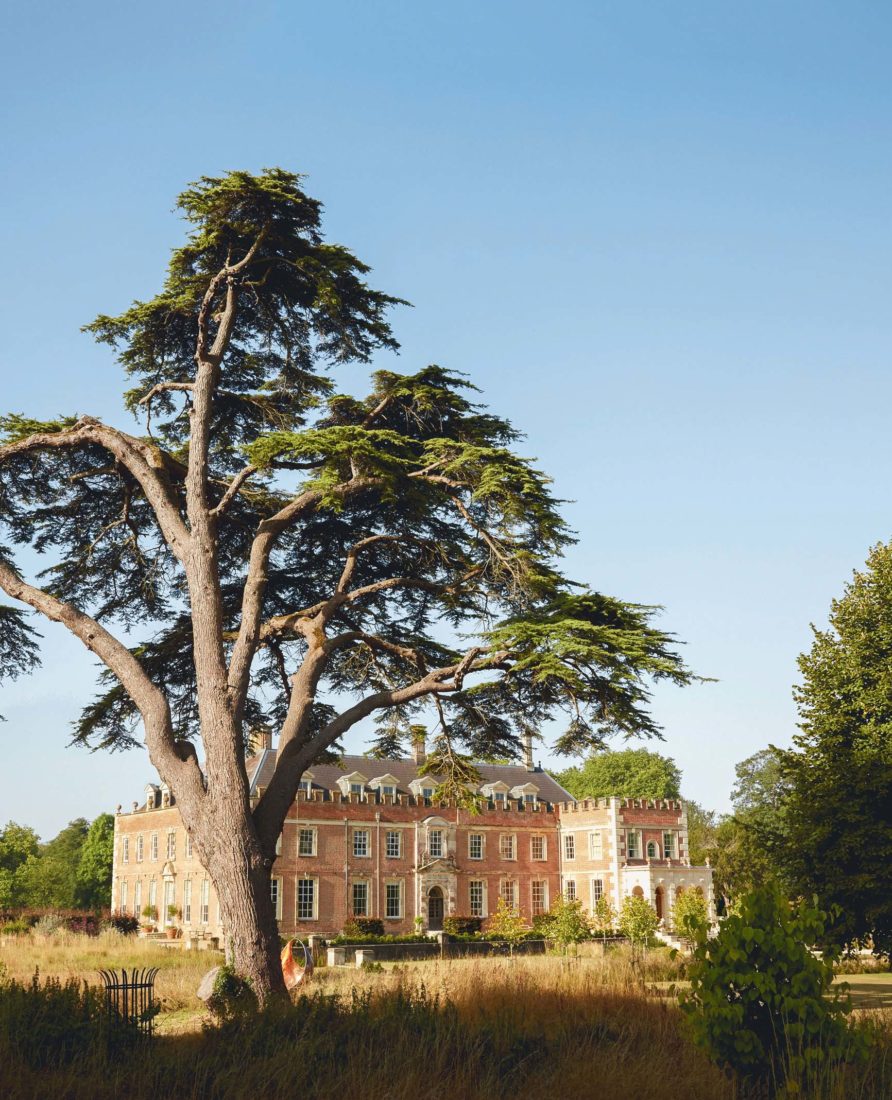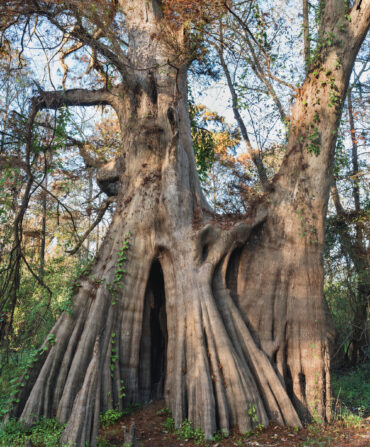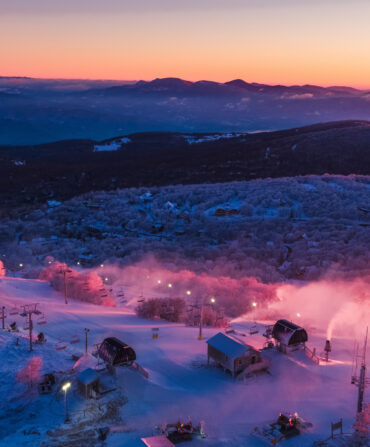If you closed your eyes and tried to picture a quintessential English country manor, you’d probably come up with something very much like Shaftesbury Estates, in East Dorset near the country’s south coast. The east side of the gargantuan redbrick main house looks onto a stately avenue of beech trees, planted in double rows on either side and extending some three-quarters of a mile toward the horizon. Not far away, you might spot a fisherman wading the shallows of the River Allen, a pristine stretch of spring-fed, clear-flowing chalk stream that looks like a setting from The Wind in the Willows, with kingfishers, otters, and a thriving population of native brown trout fattened on mayflies and minnows. At times, shotguns echo in the distance, as tweed-clad guests take aim at partridge or pheasant on a driven shoot.

Photo: Millie Pilkington/© Country Life Picture Library
The Earl and Countess of Shaftesbury, with Hettie, a German wirehaired pointer, in their dining room at St. Giles House.
“It all feels strangely normal now,” says Nicholas Ashley-Cooper, the reigning lord of the manor. In the early 2000s, though, he had landed about as far from these rolling, wooded hills and trout pools as he could get. Atmospherically speaking, at least. Known back then as “Nick AC,” he had become, as a spike-haired DJ in his early twenties, a fixture in some of New York City’s trendiest clubs, spinning electronic music and making a name among night owls for a weekly dance party called Robots. (A robot tattoo on his right arm memorializes that career phase.) But in 2005, his life took a dramatic and unforeseen turn. That year Nick, to his great surprise, became the Right Honourable Nicholas E. A. Ashley-Cooper, twelfth Earl of Shaftesbury. His story lies at the heart of a classic sporting destination, an against-the-odds revival after a chain of tragedies, and an alluring place to steal away from the twenty-first century for a weekend, or longer.
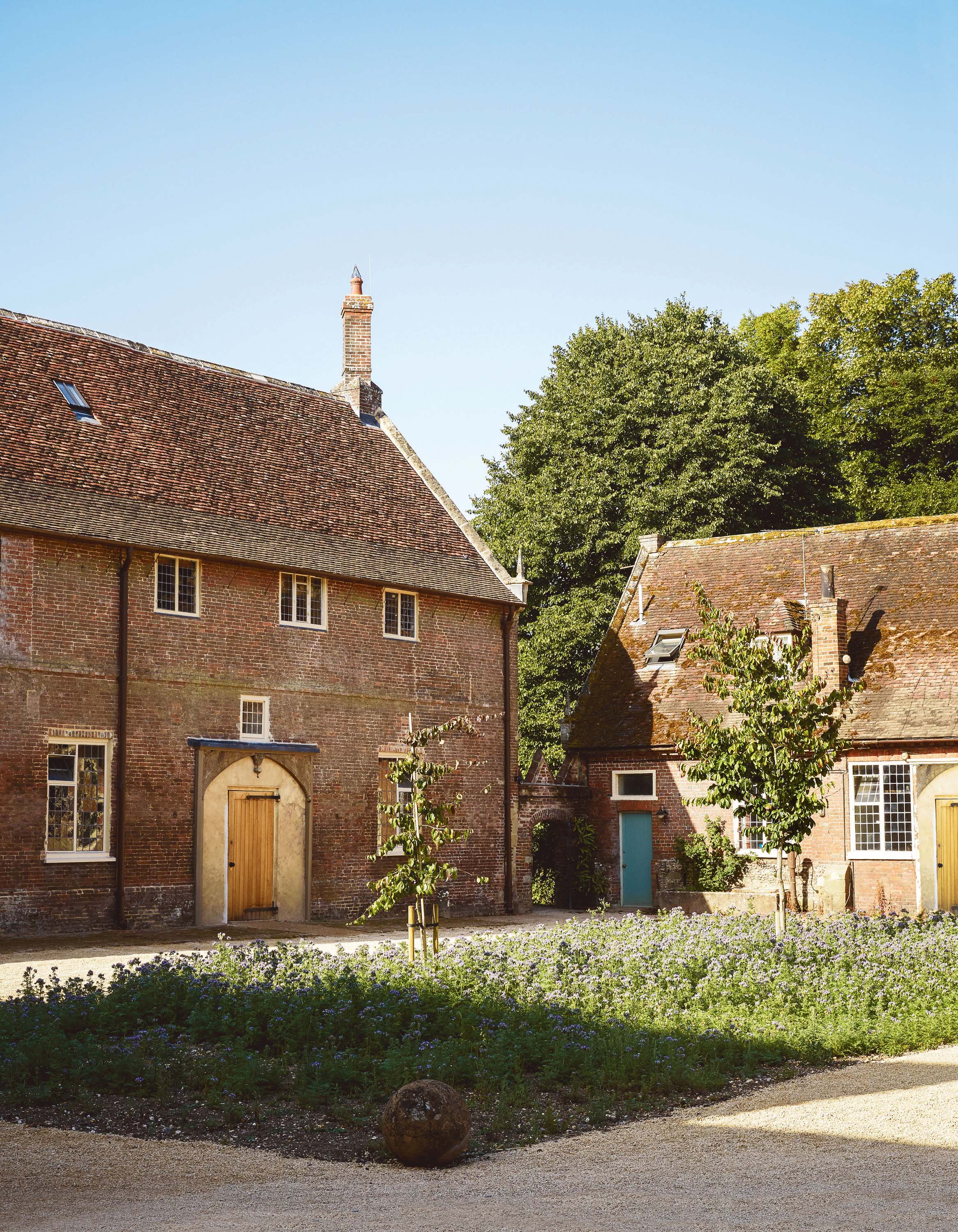
Photo: Paul Massey/House & Garden ©The Condé Nast Publications Ltd.
The exterior of the Riding House, built in 1620.
To back up a bit: The scion of a long line of British aristocrats, Ashley-Cooper grew up on this estate two hours from London, centered around a hulking Carolean mansion called St. Giles House that was built in 1650. The family had left its stamp on the history of both Great Britain and the American South. “I had this sense of family pride early on,” he says. In 1663, King Charles II named one of Nick’s forebears, the first Earl of Shaftesbury, one of the lords proprietors presiding over the new colony of Carolina, and Charleston’s Ashley and Cooper Rivers took their names from the family’s. The fourth earl and his wife befriended the composer George Frideric Handel, who often visited. The seventh earl, Nick’s great-great-great-grandfather, became one of the most admired social reformers of the Victorian era, championing relief for patients in asylums, female coal miners, boys forced at their peril to clean chimneys, and others. A statue in his memory, named The Angel of Christian Charity, sits atop a landmark fountain in London’s Piccadilly Circus.
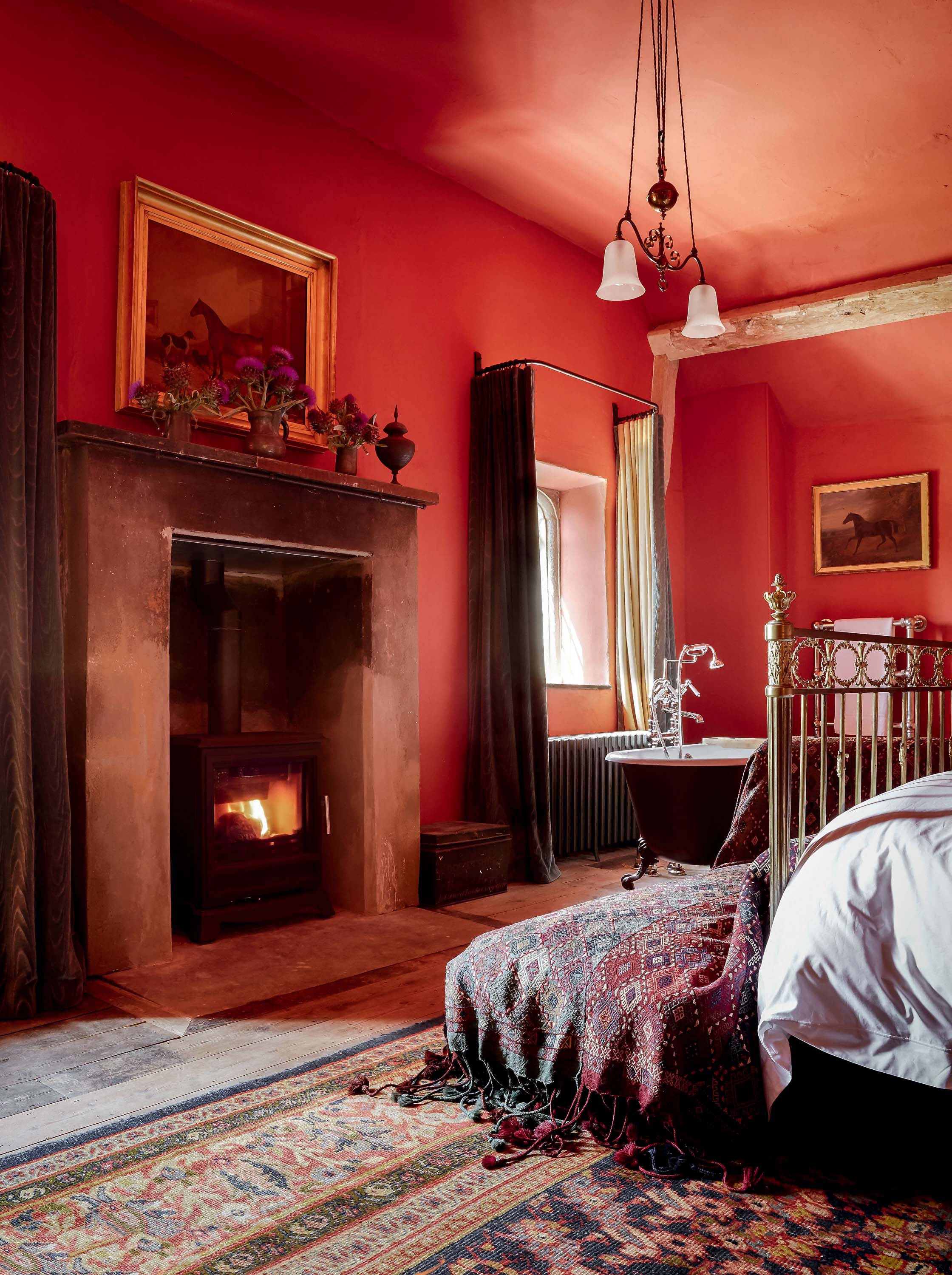
Photo: Paul Massey/House & Garden ©The Condé Nast Publications Ltd.
The main bedroom at the Riding House, available for guests.
There was one part of the family’s storied heritage, though, about which Nick knew little. “The house was the big topic that no one really dared to go near,” he recalls. He grew up, with his older brother, Anthony, and his parents, on the other side of the estate grounds. No one had lived in St. Giles House since the early 1960s, and the once-grand showpiece that at its peak boasted a household staff of forty had become a ruin in the making, suffering from the ravages of time, inheritance taxes, and years of neglect. His father, the tenth Earl (who was also named Anthony), had spent four years during the 1970s trying to resuscitate the sprawling house, but eventually gave up. He seldom spoke of the mostly shuttered St. Giles, which from the 1990s on languished on a register of historic English “Buildings at Risk.” As the second son, Nick grew up with the assurance that the title and the property would in time pass to his brother, the firstborn, and would never be his burdens to bear.
In the late 1990s, however, things began to derail. Nick’s father, a onetime chairman of the London Philharmonic Orchestra and a respected conservationist, divorced his mother, moved to the French Riviera, and plunged into a self-destructive spiral of depression, alcoholism, and chaotic behavior, chronicled with glee by the British tabloids. In 2002, to his family’s chagrin, he married a much younger escort named Jamila M’Barek and lavished her with a duplex in Cannes and a hefty monthly allowance. Before long, the marriage curdled, and in November 2004, the tenth earl vanished. Five months later, his remains turned up in a ravine a few miles outside Cannes. (M’Barek and her brother were later convicted of plotting to strangle him to death and are serving lengthy terms in French prisons.) Crueler still, just a few weeks after their father’s body was found, Nick’s brother died of a heart attack, at twenty-seven, while visiting Nick in New York. Shocked and grieving, the twenty-five-year-old DJ suddenly himself became an earl, the owner of a 5,800-acre estate, and heir to a fixer-upper of monumental proportions.
“When you looked at it, you didn’t think there was a way back, as such,” Ashley-Cooper says of the house. Buckets were lined up around the attic to catch rainwater. Black mold stained walls infested with dry rot, and sheets of plaster hung from ceilings. Birds made themselves at home amid huge old portraits and tapestries. Outside, a lake fed by river water diverted through a culvert had largely filled with silt, and bridges along its shore had collapsed. After World War II, many owners of large and unwieldy country houses had opted, understandably, for demolition. But in 2006, the newly minted earl moved back to England, studied for an MBA from the London Business School, and launched a painstaking, years-long renovation, driven by what he calls “a kind of personal mission, to get everything back on track.”

Photo: Paul Massey/House & Garden ©The Condé Nast Publications Ltd.
A bathroom includes a mirror discovered in the attic of St. Giles House.
An extraordinary turnaround gradually took shape. In 2012, Ashley-Cooper and his wife, Dinah—they married in 2010, after he proposed in front of St. Giles House—moved into modernized living quarters in the south wing, where they now reside with their three young children. A squadron of contractors, restoration specialists, and volunteer archivists converged, phase by phase. The lake was drained and dredged. In time, awards for historic preservation came from the Royal Institution of Chartered Surveyors, the Historic Houses Association, and others. Shaftesbury Estates began to buzz with weddings, arts festivals, concerts, footraces, charity fund-raisers, shooting parties, a nightclub and “speakeasy” in the basement, and the summertime Great Dorset Chilli Festival.
Today there are several inviting options for guests to stick around awhile. Although so far St. Giles House itself has no overnight lodging for visitors, groups can rent out the entire restored eight-bedroom Riding House, originally a stable built in 1620, right next door. Equestrian-themed decor, naturally, complements the antique furnishings and billiards table, and rooms include soaking tubs and king-size beds; there’s a kitchen for either self-service or catered meals. Solo travelers or couples can book one of the two smaller Pepperpot Lodges, with their own kitchens, just down the lane, or stay at the Home Farm House, a bed-and-breakfast on the estate’s grounds. For hunters, partridge season begins in September, pheasant in October, and they run through January, with shoots arranged for up to 250 birds.
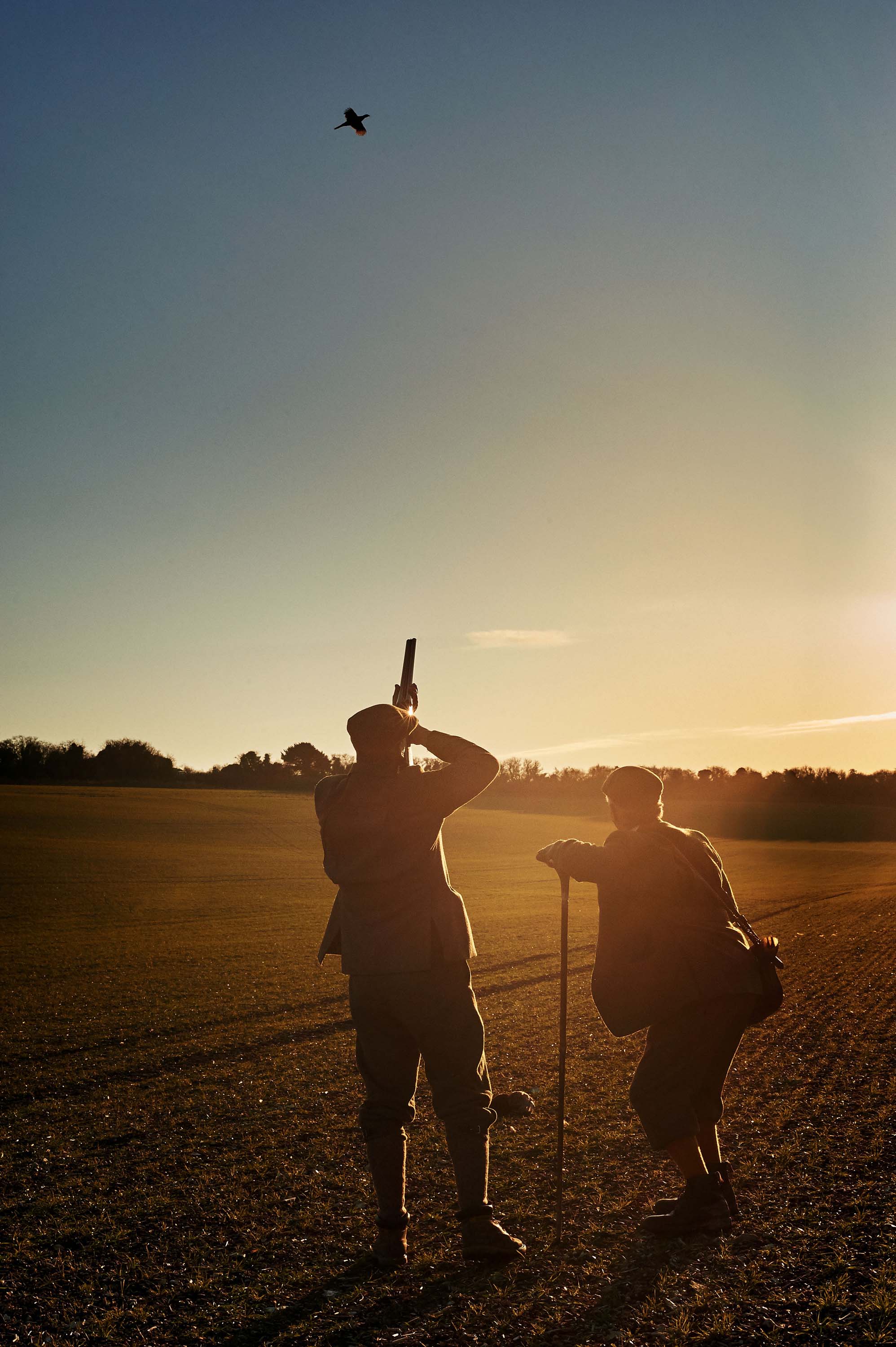
Photo: Justin Barton
Taking aim at Shaftesbury Estates.
Six of St. Giles’s interior bedrooms still await restoration, and in the next few years more resort-like amenities may be in the works: swimming pools, guest rooms in the main house, horseback riding. Far from over, the story of the estate continues to unfold, this absorbing new chapter still being written. “There’s a great energy to St. Giles now,” Ashley-Cooper says. “And there will always be things to do. Boredom isn’t one of the things we’ll be worried about.”


